Customer Behaviour Analysis for Tesco
VerifiedAdded on 2020/02/17
|15
|4249
|54
AI Summary
This assignment delves into the realm of customer behavior, specifically analyzing how various theoretical models can be applied to understand consumer purchasing decisions within the context of Tesco, a leading global supermarket chain. The assignment examines relevant theories like the Theory of Reasoned Action and the Service-Profit Chain, drawing upon research papers and real-world examples to illustrate their practical implications for businesses. A key focus is on analyzing Tesco's business model, its strategies for customer satisfaction, and the impact of factors such as service quality, experiential marketing, and social media on consumer loyalty.
Contribute Materials
Your contribution can guide someone’s learning journey. Share your
documents today.
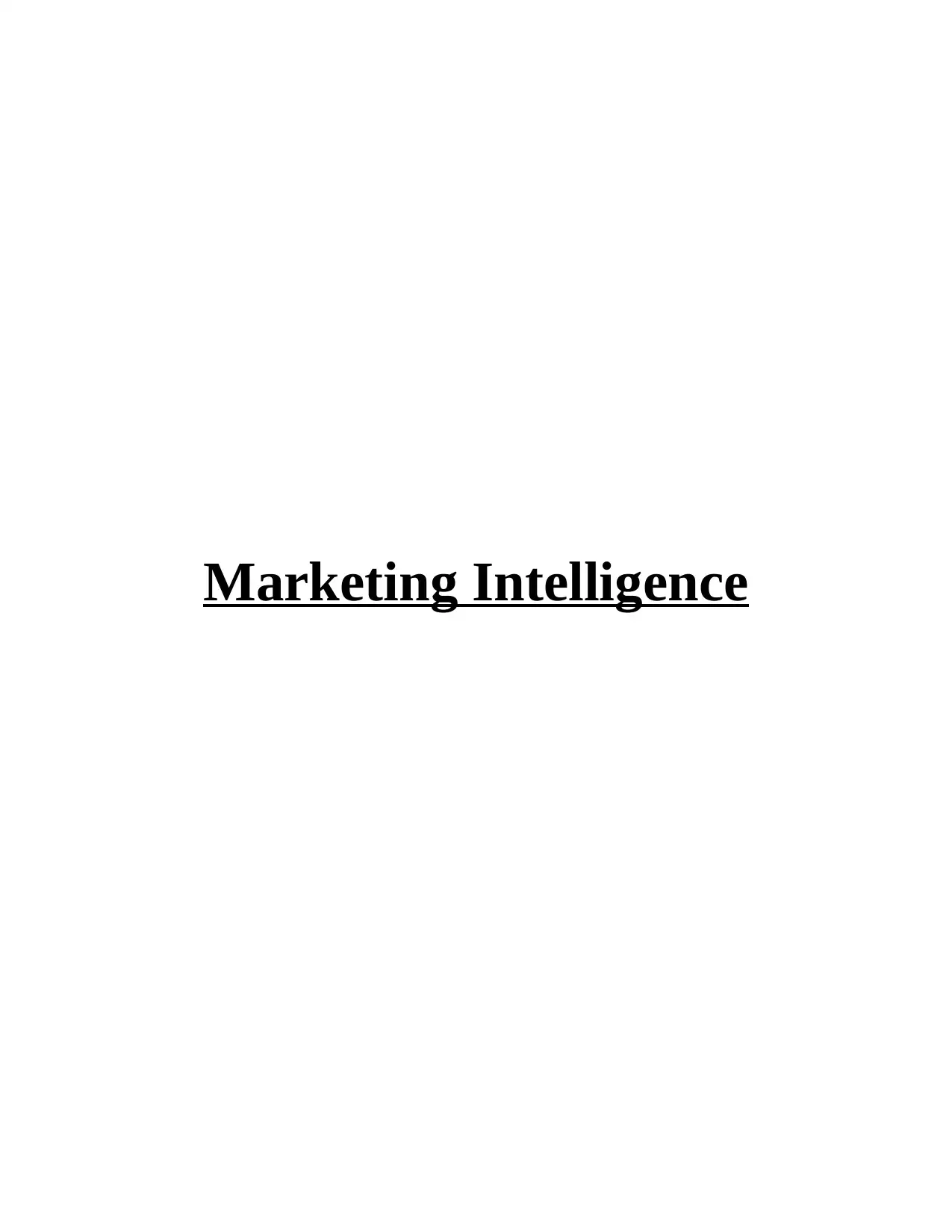
Marketing Intelligence
Secure Best Marks with AI Grader
Need help grading? Try our AI Grader for instant feedback on your assignments.
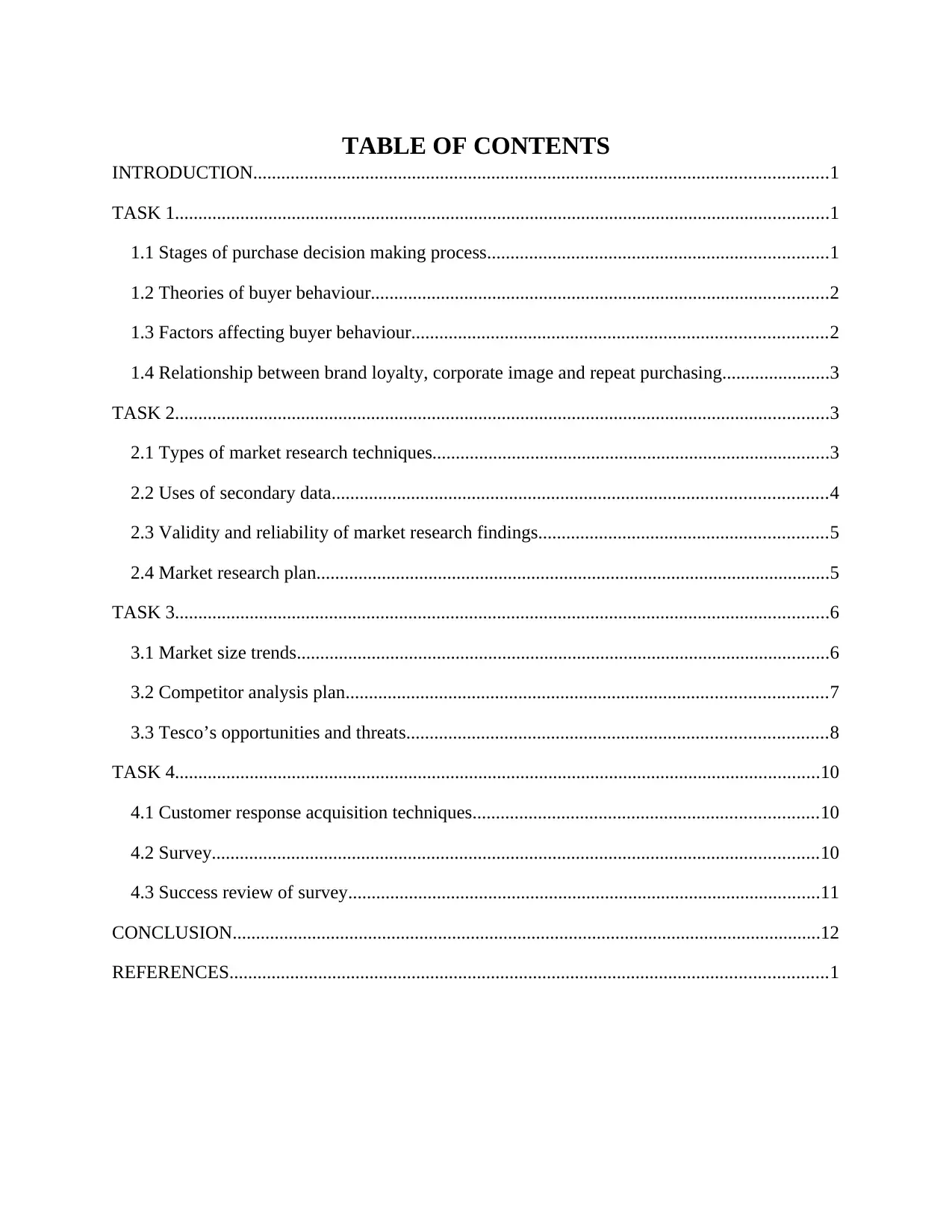
TABLE OF CONTENTS
INTRODUCTION...........................................................................................................................1
TASK 1............................................................................................................................................1
1.1 Stages of purchase decision making process.........................................................................1
1.2 Theories of buyer behaviour..................................................................................................2
1.3 Factors affecting buyer behaviour.........................................................................................2
1.4 Relationship between brand loyalty, corporate image and repeat purchasing.......................3
TASK 2............................................................................................................................................3
2.1 Types of market research techniques.....................................................................................3
2.2 Uses of secondary data..........................................................................................................4
2.3 Validity and reliability of market research findings..............................................................5
2.4 Market research plan..............................................................................................................5
TASK 3............................................................................................................................................6
3.1 Market size trends..................................................................................................................6
3.2 Competitor analysis plan.......................................................................................................7
3.3 Tesco’s opportunities and threats..........................................................................................8
TASK 4..........................................................................................................................................10
4.1 Customer response acquisition techniques..........................................................................10
4.2 Survey..................................................................................................................................10
4.3 Success review of survey.....................................................................................................11
CONCLUSION..............................................................................................................................12
REFERENCES................................................................................................................................1
INTRODUCTION...........................................................................................................................1
TASK 1............................................................................................................................................1
1.1 Stages of purchase decision making process.........................................................................1
1.2 Theories of buyer behaviour..................................................................................................2
1.3 Factors affecting buyer behaviour.........................................................................................2
1.4 Relationship between brand loyalty, corporate image and repeat purchasing.......................3
TASK 2............................................................................................................................................3
2.1 Types of market research techniques.....................................................................................3
2.2 Uses of secondary data..........................................................................................................4
2.3 Validity and reliability of market research findings..............................................................5
2.4 Market research plan..............................................................................................................5
TASK 3............................................................................................................................................6
3.1 Market size trends..................................................................................................................6
3.2 Competitor analysis plan.......................................................................................................7
3.3 Tesco’s opportunities and threats..........................................................................................8
TASK 4..........................................................................................................................................10
4.1 Customer response acquisition techniques..........................................................................10
4.2 Survey..................................................................................................................................10
4.3 Success review of survey.....................................................................................................11
CONCLUSION..............................................................................................................................12
REFERENCES................................................................................................................................1
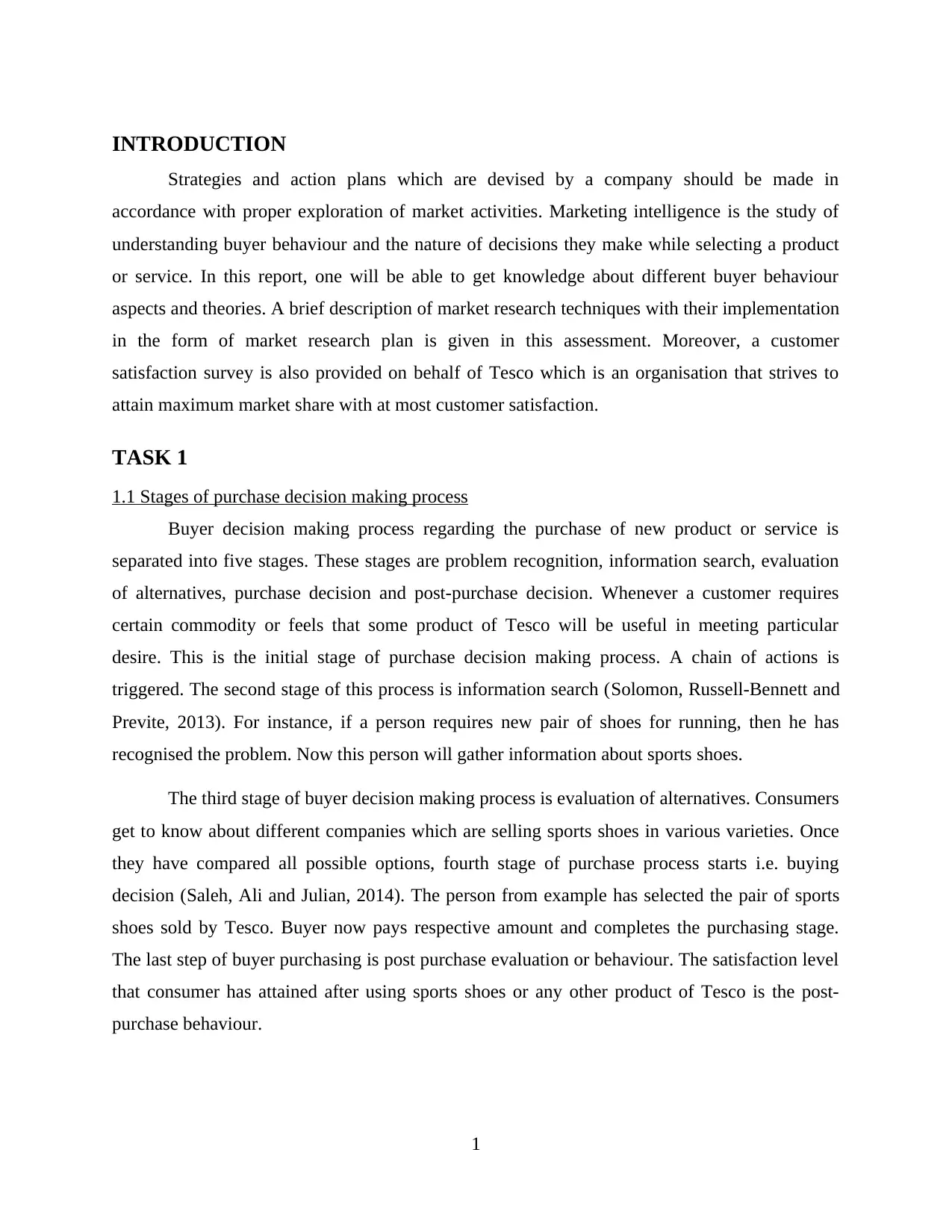
INTRODUCTION
Strategies and action plans which are devised by a company should be made in
accordance with proper exploration of market activities. Marketing intelligence is the study of
understanding buyer behaviour and the nature of decisions they make while selecting a product
or service. In this report, one will be able to get knowledge about different buyer behaviour
aspects and theories. A brief description of market research techniques with their implementation
in the form of market research plan is given in this assessment. Moreover, a customer
satisfaction survey is also provided on behalf of Tesco which is an organisation that strives to
attain maximum market share with at most customer satisfaction.
TASK 1
1.1 Stages of purchase decision making process
Buyer decision making process regarding the purchase of new product or service is
separated into five stages. These stages are problem recognition, information search, evaluation
of alternatives, purchase decision and post-purchase decision. Whenever a customer requires
certain commodity or feels that some product of Tesco will be useful in meeting particular
desire. This is the initial stage of purchase decision making process. A chain of actions is
triggered. The second stage of this process is information search (Solomon, Russell-Bennett and
Previte, 2013). For instance, if a person requires new pair of shoes for running, then he has
recognised the problem. Now this person will gather information about sports shoes.
The third stage of buyer decision making process is evaluation of alternatives. Consumers
get to know about different companies which are selling sports shoes in various varieties. Once
they have compared all possible options, fourth stage of purchase process starts i.e. buying
decision (Saleh, Ali and Julian, 2014). The person from example has selected the pair of sports
shoes sold by Tesco. Buyer now pays respective amount and completes the purchasing stage.
The last step of buyer purchasing is post purchase evaluation or behaviour. The satisfaction level
that consumer has attained after using sports shoes or any other product of Tesco is the post-
purchase behaviour.
1
Strategies and action plans which are devised by a company should be made in
accordance with proper exploration of market activities. Marketing intelligence is the study of
understanding buyer behaviour and the nature of decisions they make while selecting a product
or service. In this report, one will be able to get knowledge about different buyer behaviour
aspects and theories. A brief description of market research techniques with their implementation
in the form of market research plan is given in this assessment. Moreover, a customer
satisfaction survey is also provided on behalf of Tesco which is an organisation that strives to
attain maximum market share with at most customer satisfaction.
TASK 1
1.1 Stages of purchase decision making process
Buyer decision making process regarding the purchase of new product or service is
separated into five stages. These stages are problem recognition, information search, evaluation
of alternatives, purchase decision and post-purchase decision. Whenever a customer requires
certain commodity or feels that some product of Tesco will be useful in meeting particular
desire. This is the initial stage of purchase decision making process. A chain of actions is
triggered. The second stage of this process is information search (Solomon, Russell-Bennett and
Previte, 2013). For instance, if a person requires new pair of shoes for running, then he has
recognised the problem. Now this person will gather information about sports shoes.
The third stage of buyer decision making process is evaluation of alternatives. Consumers
get to know about different companies which are selling sports shoes in various varieties. Once
they have compared all possible options, fourth stage of purchase process starts i.e. buying
decision (Saleh, Ali and Julian, 2014). The person from example has selected the pair of sports
shoes sold by Tesco. Buyer now pays respective amount and completes the purchasing stage.
The last step of buyer purchasing is post purchase evaluation or behaviour. The satisfaction level
that consumer has attained after using sports shoes or any other product of Tesco is the post-
purchase behaviour.
1
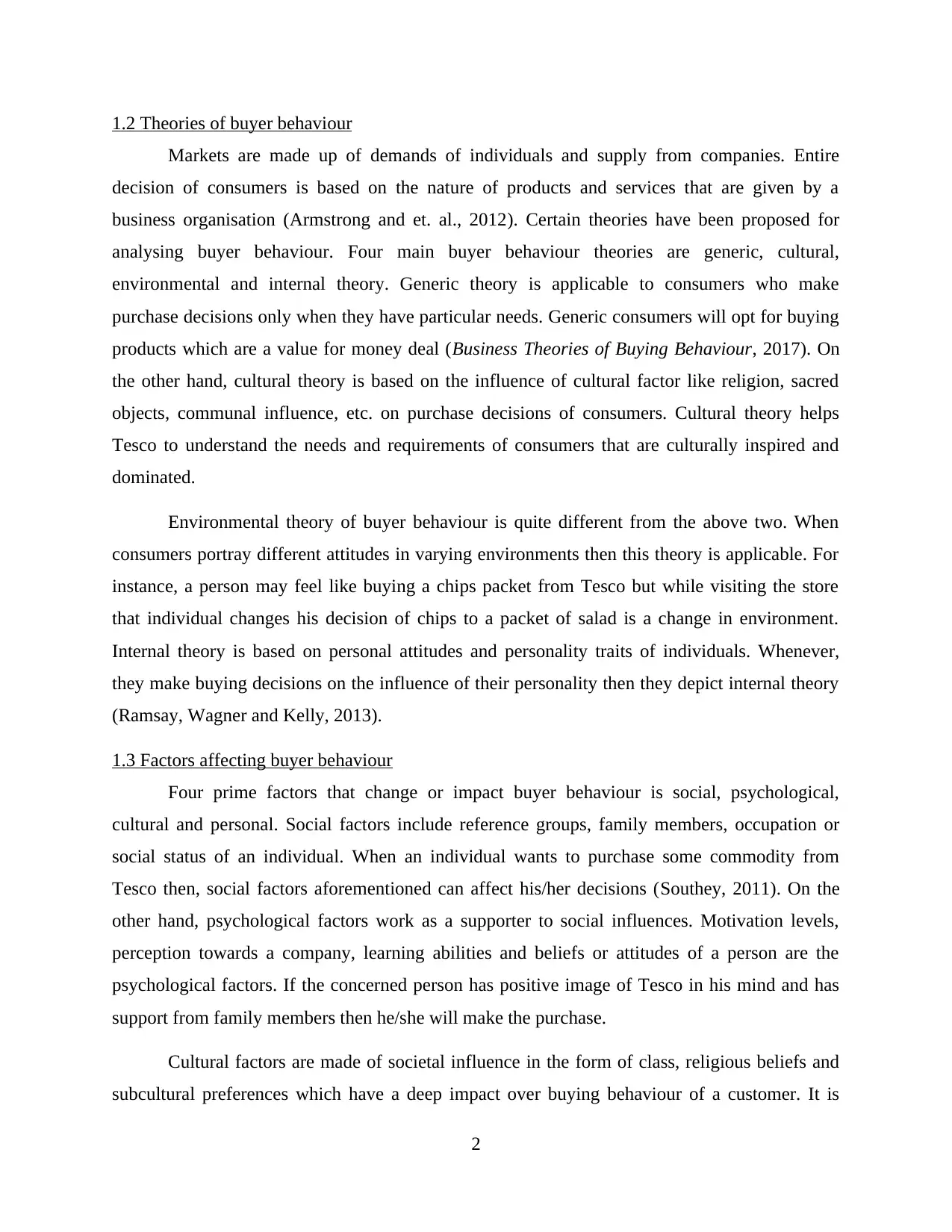
1.2 Theories of buyer behaviour
Markets are made up of demands of individuals and supply from companies. Entire
decision of consumers is based on the nature of products and services that are given by a
business organisation (Armstrong and et. al., 2012). Certain theories have been proposed for
analysing buyer behaviour. Four main buyer behaviour theories are generic, cultural,
environmental and internal theory. Generic theory is applicable to consumers who make
purchase decisions only when they have particular needs. Generic consumers will opt for buying
products which are a value for money deal (Business Theories of Buying Behaviour, 2017). On
the other hand, cultural theory is based on the influence of cultural factor like religion, sacred
objects, communal influence, etc. on purchase decisions of consumers. Cultural theory helps
Tesco to understand the needs and requirements of consumers that are culturally inspired and
dominated.
Environmental theory of buyer behaviour is quite different from the above two. When
consumers portray different attitudes in varying environments then this theory is applicable. For
instance, a person may feel like buying a chips packet from Tesco but while visiting the store
that individual changes his decision of chips to a packet of salad is a change in environment.
Internal theory is based on personal attitudes and personality traits of individuals. Whenever,
they make buying decisions on the influence of their personality then they depict internal theory
(Ramsay, Wagner and Kelly, 2013).
1.3 Factors affecting buyer behaviour
Four prime factors that change or impact buyer behaviour is social, psychological,
cultural and personal. Social factors include reference groups, family members, occupation or
social status of an individual. When an individual wants to purchase some commodity from
Tesco then, social factors aforementioned can affect his/her decisions (Southey, 2011). On the
other hand, psychological factors work as a supporter to social influences. Motivation levels,
perception towards a company, learning abilities and beliefs or attitudes of a person are the
psychological factors. If the concerned person has positive image of Tesco in his mind and has
support from family members then he/she will make the purchase.
Cultural factors are made of societal influence in the form of class, religious beliefs and
subcultural preferences which have a deep impact over buying behaviour of a customer. It is
2
Markets are made up of demands of individuals and supply from companies. Entire
decision of consumers is based on the nature of products and services that are given by a
business organisation (Armstrong and et. al., 2012). Certain theories have been proposed for
analysing buyer behaviour. Four main buyer behaviour theories are generic, cultural,
environmental and internal theory. Generic theory is applicable to consumers who make
purchase decisions only when they have particular needs. Generic consumers will opt for buying
products which are a value for money deal (Business Theories of Buying Behaviour, 2017). On
the other hand, cultural theory is based on the influence of cultural factor like religion, sacred
objects, communal influence, etc. on purchase decisions of consumers. Cultural theory helps
Tesco to understand the needs and requirements of consumers that are culturally inspired and
dominated.
Environmental theory of buyer behaviour is quite different from the above two. When
consumers portray different attitudes in varying environments then this theory is applicable. For
instance, a person may feel like buying a chips packet from Tesco but while visiting the store
that individual changes his decision of chips to a packet of salad is a change in environment.
Internal theory is based on personal attitudes and personality traits of individuals. Whenever,
they make buying decisions on the influence of their personality then they depict internal theory
(Ramsay, Wagner and Kelly, 2013).
1.3 Factors affecting buyer behaviour
Four prime factors that change or impact buyer behaviour is social, psychological,
cultural and personal. Social factors include reference groups, family members, occupation or
social status of an individual. When an individual wants to purchase some commodity from
Tesco then, social factors aforementioned can affect his/her decisions (Southey, 2011). On the
other hand, psychological factors work as a supporter to social influences. Motivation levels,
perception towards a company, learning abilities and beliefs or attitudes of a person are the
psychological factors. If the concerned person has positive image of Tesco in his mind and has
support from family members then he/she will make the purchase.
Cultural factors are made of societal influence in the form of class, religious beliefs and
subcultural preferences which have a deep impact over buying behaviour of a customer. It is
2
Secure Best Marks with AI Grader
Need help grading? Try our AI Grader for instant feedback on your assignments.
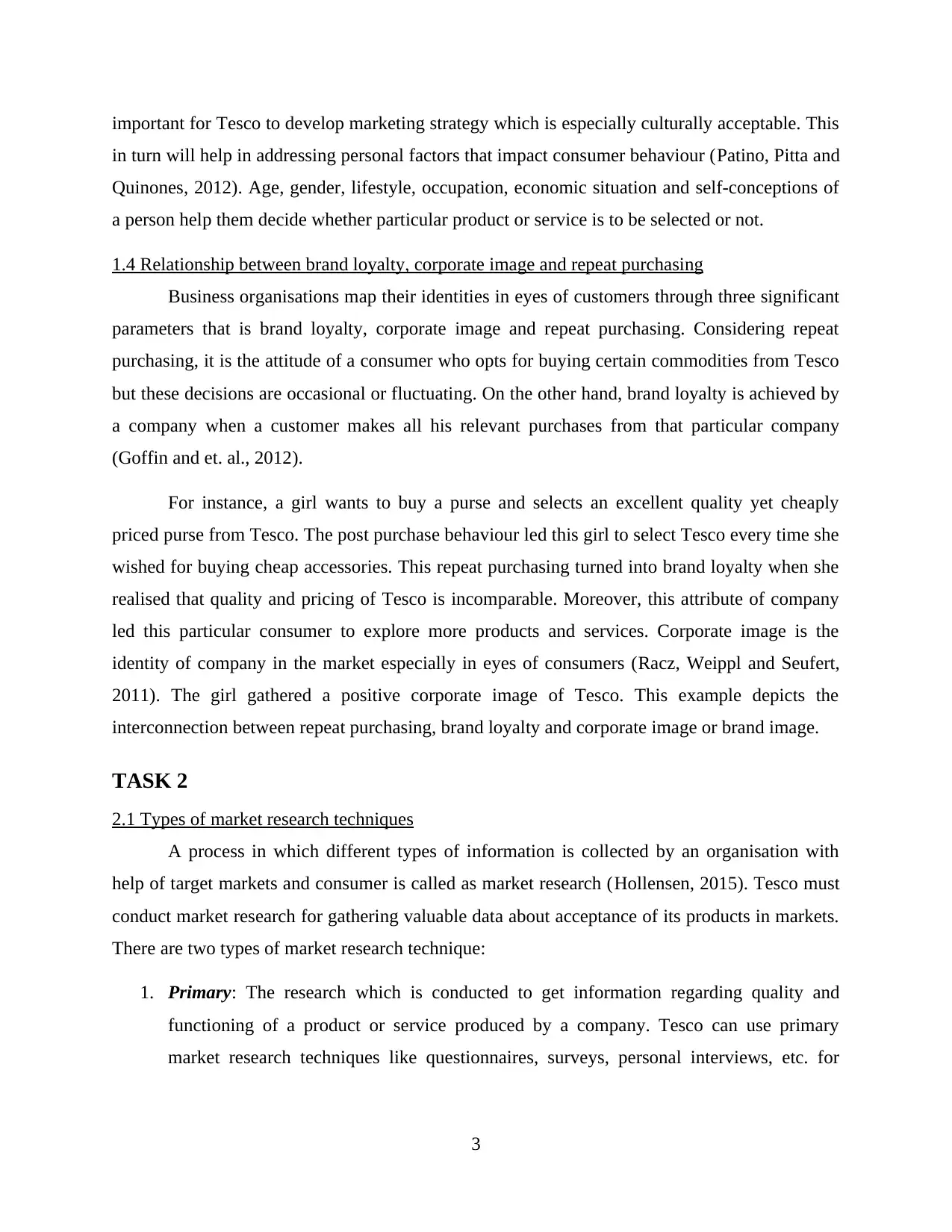
important for Tesco to develop marketing strategy which is especially culturally acceptable. This
in turn will help in addressing personal factors that impact consumer behaviour (Patino, Pitta and
Quinones, 2012). Age, gender, lifestyle, occupation, economic situation and self-conceptions of
a person help them decide whether particular product or service is to be selected or not.
1.4 Relationship between brand loyalty, corporate image and repeat purchasing
Business organisations map their identities in eyes of customers through three significant
parameters that is brand loyalty, corporate image and repeat purchasing. Considering repeat
purchasing, it is the attitude of a consumer who opts for buying certain commodities from Tesco
but these decisions are occasional or fluctuating. On the other hand, brand loyalty is achieved by
a company when a customer makes all his relevant purchases from that particular company
(Goffin and et. al., 2012).
For instance, a girl wants to buy a purse and selects an excellent quality yet cheaply
priced purse from Tesco. The post purchase behaviour led this girl to select Tesco every time she
wished for buying cheap accessories. This repeat purchasing turned into brand loyalty when she
realised that quality and pricing of Tesco is incomparable. Moreover, this attribute of company
led this particular consumer to explore more products and services. Corporate image is the
identity of company in the market especially in eyes of consumers (Racz, Weippl and Seufert,
2011). The girl gathered a positive corporate image of Tesco. This example depicts the
interconnection between repeat purchasing, brand loyalty and corporate image or brand image.
TASK 2
2.1 Types of market research techniques
A process in which different types of information is collected by an organisation with
help of target markets and consumer is called as market research (Hollensen, 2015). Tesco must
conduct market research for gathering valuable data about acceptance of its products in markets.
There are two types of market research technique:
1. Primary: The research which is conducted to get information regarding quality and
functioning of a product or service produced by a company. Tesco can use primary
market research techniques like questionnaires, surveys, personal interviews, etc. for
3
in turn will help in addressing personal factors that impact consumer behaviour (Patino, Pitta and
Quinones, 2012). Age, gender, lifestyle, occupation, economic situation and self-conceptions of
a person help them decide whether particular product or service is to be selected or not.
1.4 Relationship between brand loyalty, corporate image and repeat purchasing
Business organisations map their identities in eyes of customers through three significant
parameters that is brand loyalty, corporate image and repeat purchasing. Considering repeat
purchasing, it is the attitude of a consumer who opts for buying certain commodities from Tesco
but these decisions are occasional or fluctuating. On the other hand, brand loyalty is achieved by
a company when a customer makes all his relevant purchases from that particular company
(Goffin and et. al., 2012).
For instance, a girl wants to buy a purse and selects an excellent quality yet cheaply
priced purse from Tesco. The post purchase behaviour led this girl to select Tesco every time she
wished for buying cheap accessories. This repeat purchasing turned into brand loyalty when she
realised that quality and pricing of Tesco is incomparable. Moreover, this attribute of company
led this particular consumer to explore more products and services. Corporate image is the
identity of company in the market especially in eyes of consumers (Racz, Weippl and Seufert,
2011). The girl gathered a positive corporate image of Tesco. This example depicts the
interconnection between repeat purchasing, brand loyalty and corporate image or brand image.
TASK 2
2.1 Types of market research techniques
A process in which different types of information is collected by an organisation with
help of target markets and consumer is called as market research (Hollensen, 2015). Tesco must
conduct market research for gathering valuable data about acceptance of its products in markets.
There are two types of market research technique:
1. Primary: The research which is conducted to get information regarding quality and
functioning of a product or service produced by a company. Tesco can use primary
market research techniques like questionnaires, surveys, personal interviews, etc. for
3
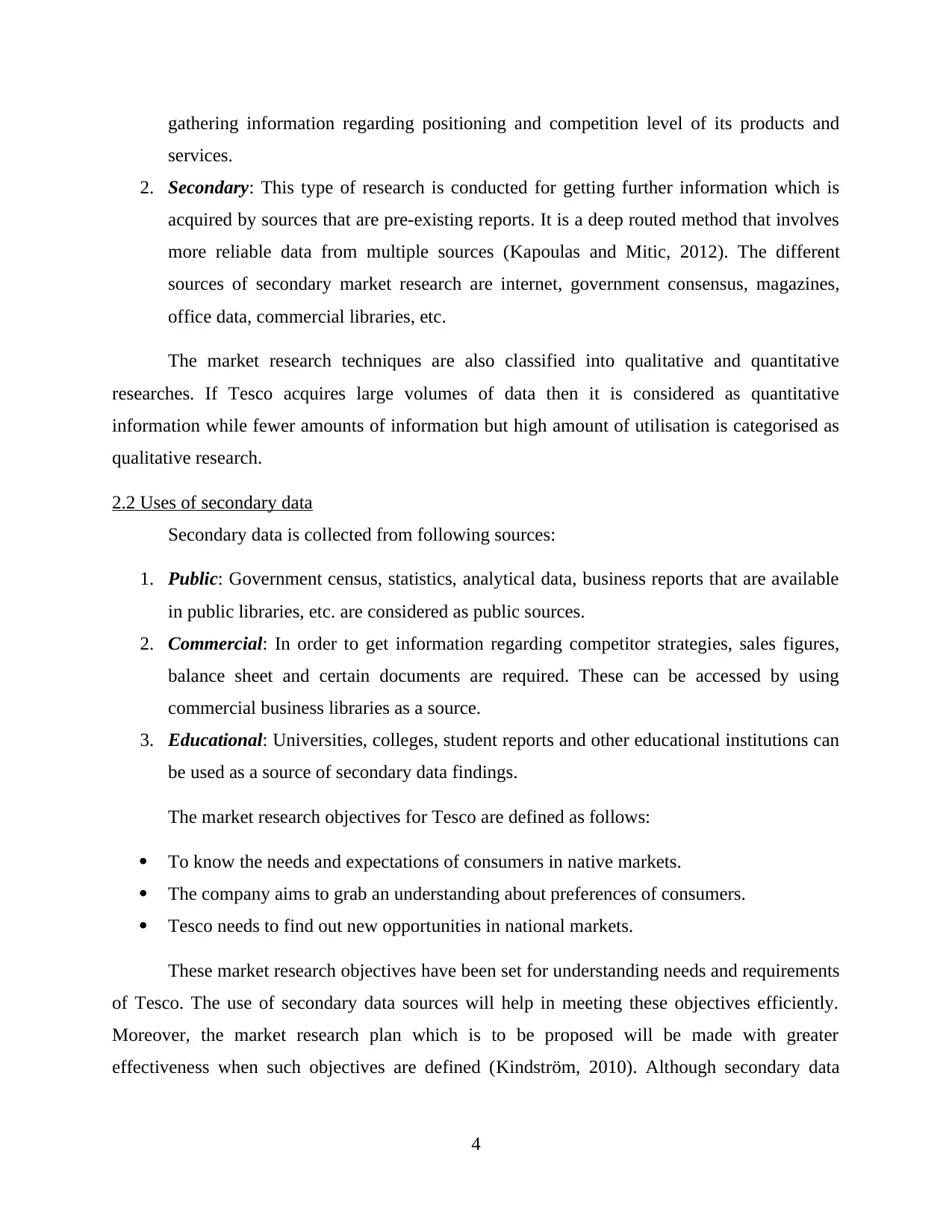
gathering information regarding positioning and competition level of its products and
services.
2. Secondary: This type of research is conducted for getting further information which is
acquired by sources that are pre-existing reports. It is a deep routed method that involves
more reliable data from multiple sources (Kapoulas and Mitic, 2012). The different
sources of secondary market research are internet, government consensus, magazines,
office data, commercial libraries, etc.
The market research techniques are also classified into qualitative and quantitative
researches. If Tesco acquires large volumes of data then it is considered as quantitative
information while fewer amounts of information but high amount of utilisation is categorised as
qualitative research.
2.2 Uses of secondary data
Secondary data is collected from following sources:
1. Public: Government census, statistics, analytical data, business reports that are available
in public libraries, etc. are considered as public sources.
2. Commercial: In order to get information regarding competitor strategies, sales figures,
balance sheet and certain documents are required. These can be accessed by using
commercial business libraries as a source.
3. Educational: Universities, colleges, student reports and other educational institutions can
be used as a source of secondary data findings.
The market research objectives for Tesco are defined as follows:
To know the needs and expectations of consumers in native markets.
The company aims to grab an understanding about preferences of consumers.
Tesco needs to find out new opportunities in national markets.
These market research objectives have been set for understanding needs and requirements
of Tesco. The use of secondary data sources will help in meeting these objectives efficiently.
Moreover, the market research plan which is to be proposed will be made with greater
effectiveness when such objectives are defined (Kindström, 2010). Although secondary data
4
services.
2. Secondary: This type of research is conducted for getting further information which is
acquired by sources that are pre-existing reports. It is a deep routed method that involves
more reliable data from multiple sources (Kapoulas and Mitic, 2012). The different
sources of secondary market research are internet, government consensus, magazines,
office data, commercial libraries, etc.
The market research techniques are also classified into qualitative and quantitative
researches. If Tesco acquires large volumes of data then it is considered as quantitative
information while fewer amounts of information but high amount of utilisation is categorised as
qualitative research.
2.2 Uses of secondary data
Secondary data is collected from following sources:
1. Public: Government census, statistics, analytical data, business reports that are available
in public libraries, etc. are considered as public sources.
2. Commercial: In order to get information regarding competitor strategies, sales figures,
balance sheet and certain documents are required. These can be accessed by using
commercial business libraries as a source.
3. Educational: Universities, colleges, student reports and other educational institutions can
be used as a source of secondary data findings.
The market research objectives for Tesco are defined as follows:
To know the needs and expectations of consumers in native markets.
The company aims to grab an understanding about preferences of consumers.
Tesco needs to find out new opportunities in national markets.
These market research objectives have been set for understanding needs and requirements
of Tesco. The use of secondary data sources will help in meeting these objectives efficiently.
Moreover, the market research plan which is to be proposed will be made with greater
effectiveness when such objectives are defined (Kindström, 2010). Although secondary data
4
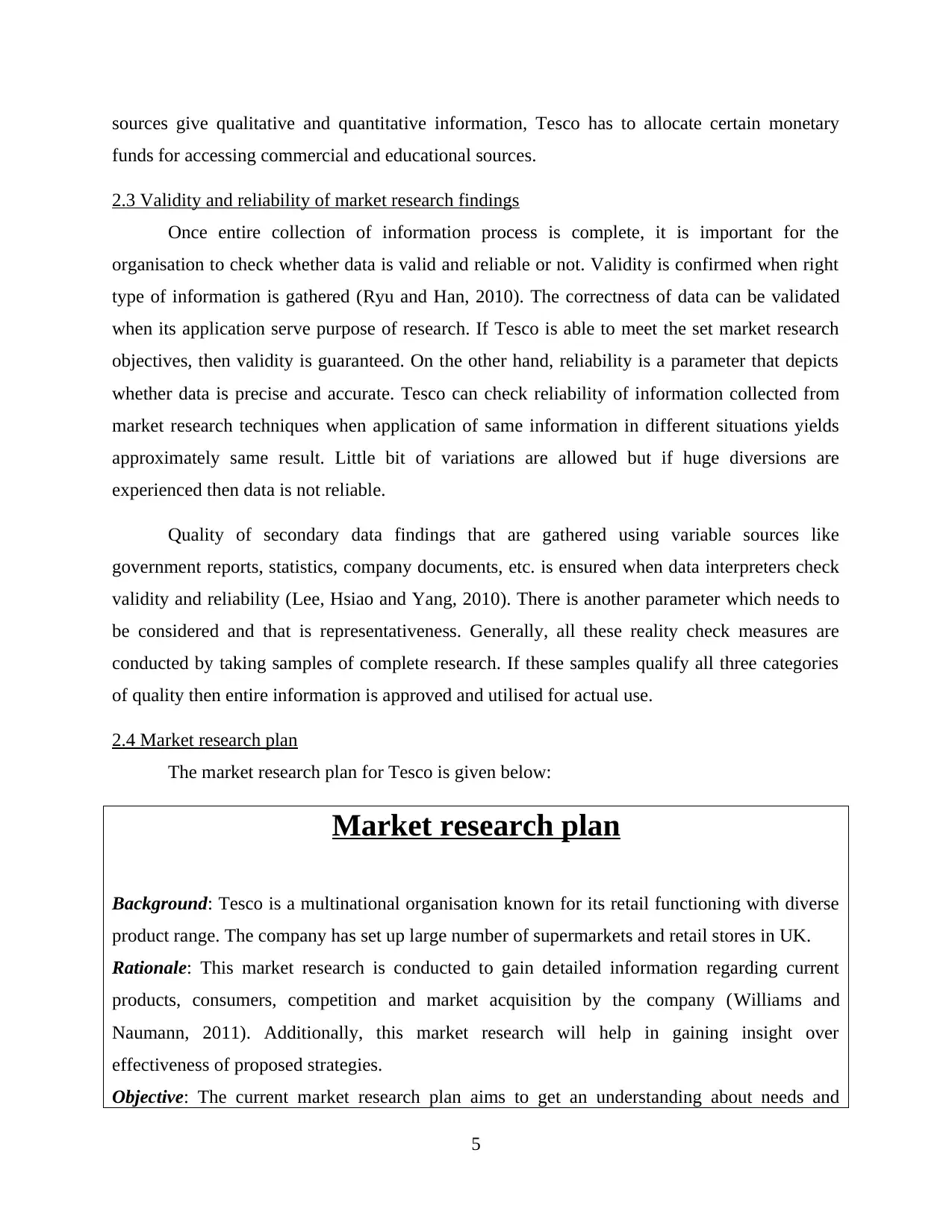
sources give qualitative and quantitative information, Tesco has to allocate certain monetary
funds for accessing commercial and educational sources.
2.3 Validity and reliability of market research findings
Once entire collection of information process is complete, it is important for the
organisation to check whether data is valid and reliable or not. Validity is confirmed when right
type of information is gathered (Ryu and Han, 2010). The correctness of data can be validated
when its application serve purpose of research. If Tesco is able to meet the set market research
objectives, then validity is guaranteed. On the other hand, reliability is a parameter that depicts
whether data is precise and accurate. Tesco can check reliability of information collected from
market research techniques when application of same information in different situations yields
approximately same result. Little bit of variations are allowed but if huge diversions are
experienced then data is not reliable.
Quality of secondary data findings that are gathered using variable sources like
government reports, statistics, company documents, etc. is ensured when data interpreters check
validity and reliability (Lee, Hsiao and Yang, 2010). There is another parameter which needs to
be considered and that is representativeness. Generally, all these reality check measures are
conducted by taking samples of complete research. If these samples qualify all three categories
of quality then entire information is approved and utilised for actual use.
2.4 Market research plan
The market research plan for Tesco is given below:
Market research plan
Background: Tesco is a multinational organisation known for its retail functioning with diverse
product range. The company has set up large number of supermarkets and retail stores in UK.
Rationale: This market research is conducted to gain detailed information regarding current
products, consumers, competition and market acquisition by the company (Williams and
Naumann, 2011). Additionally, this market research will help in gaining insight over
effectiveness of proposed strategies.
Objective: The current market research plan aims to get an understanding about needs and
5
funds for accessing commercial and educational sources.
2.3 Validity and reliability of market research findings
Once entire collection of information process is complete, it is important for the
organisation to check whether data is valid and reliable or not. Validity is confirmed when right
type of information is gathered (Ryu and Han, 2010). The correctness of data can be validated
when its application serve purpose of research. If Tesco is able to meet the set market research
objectives, then validity is guaranteed. On the other hand, reliability is a parameter that depicts
whether data is precise and accurate. Tesco can check reliability of information collected from
market research techniques when application of same information in different situations yields
approximately same result. Little bit of variations are allowed but if huge diversions are
experienced then data is not reliable.
Quality of secondary data findings that are gathered using variable sources like
government reports, statistics, company documents, etc. is ensured when data interpreters check
validity and reliability (Lee, Hsiao and Yang, 2010). There is another parameter which needs to
be considered and that is representativeness. Generally, all these reality check measures are
conducted by taking samples of complete research. If these samples qualify all three categories
of quality then entire information is approved and utilised for actual use.
2.4 Market research plan
The market research plan for Tesco is given below:
Market research plan
Background: Tesco is a multinational organisation known for its retail functioning with diverse
product range. The company has set up large number of supermarkets and retail stores in UK.
Rationale: This market research is conducted to gain detailed information regarding current
products, consumers, competition and market acquisition by the company (Williams and
Naumann, 2011). Additionally, this market research will help in gaining insight over
effectiveness of proposed strategies.
Objective: The current market research plan aims to get an understanding about needs and
5
Paraphrase This Document
Need a fresh take? Get an instant paraphrase of this document with our AI Paraphraser

preferences of customers. Also, the purpose of this plan is to explore current market
opportunities which can be developed by the company.
Research methodology: Tesco will conduct two types of researches that is:
Primary research techniques: Survey in the form of questionnaire and personal
interviews shall be conducted focusing on brand loyal consumers. These will give both
qualitative and quantitative information.
Secondary research techniques: Balance sheets and statistical figures of competitors will
be used as the source of secondary research. Public sources will also be accessed for
gathering information.
Data analysis: The collected data is to be analysed and examined so that validity and reliability
is checked. This step is important because all future decisions are based entirely on these
parameters.
Time Frame: The research will be conducted in 6 months of implementation.
Budget: Tesco has allocated a budget of £45,000. Entire expenses have to be covered in this
budget.
TASK 3
3.1 Market size trends
Markets are the only source of income for every business organisation. Tesco has been
operating in UK since 1919 i.e. 98 years. The company has been ranked as third largest profit
earning organisation with stores in Asia and Europe. Current market trends are established in
digital marketing (Clark, 2016). Social media has emerged as the biggest network for sharing
information. Businesses have utilised this platform for earning profits. Total market size of
Tesco is estimated to be £54.433 billion with a huge contribution to country’s gross domestic
product. This size depicts that despite of heavy competition; Tesco has been able to get majority
consumers with an edge.
6
opportunities which can be developed by the company.
Research methodology: Tesco will conduct two types of researches that is:
Primary research techniques: Survey in the form of questionnaire and personal
interviews shall be conducted focusing on brand loyal consumers. These will give both
qualitative and quantitative information.
Secondary research techniques: Balance sheets and statistical figures of competitors will
be used as the source of secondary research. Public sources will also be accessed for
gathering information.
Data analysis: The collected data is to be analysed and examined so that validity and reliability
is checked. This step is important because all future decisions are based entirely on these
parameters.
Time Frame: The research will be conducted in 6 months of implementation.
Budget: Tesco has allocated a budget of £45,000. Entire expenses have to be covered in this
budget.
TASK 3
3.1 Market size trends
Markets are the only source of income for every business organisation. Tesco has been
operating in UK since 1919 i.e. 98 years. The company has been ranked as third largest profit
earning organisation with stores in Asia and Europe. Current market trends are established in
digital marketing (Clark, 2016). Social media has emerged as the biggest network for sharing
information. Businesses have utilised this platform for earning profits. Total market size of
Tesco is estimated to be £54.433 billion with a huge contribution to country’s gross domestic
product. This size depicts that despite of heavy competition; Tesco has been able to get majority
consumers with an edge.
6
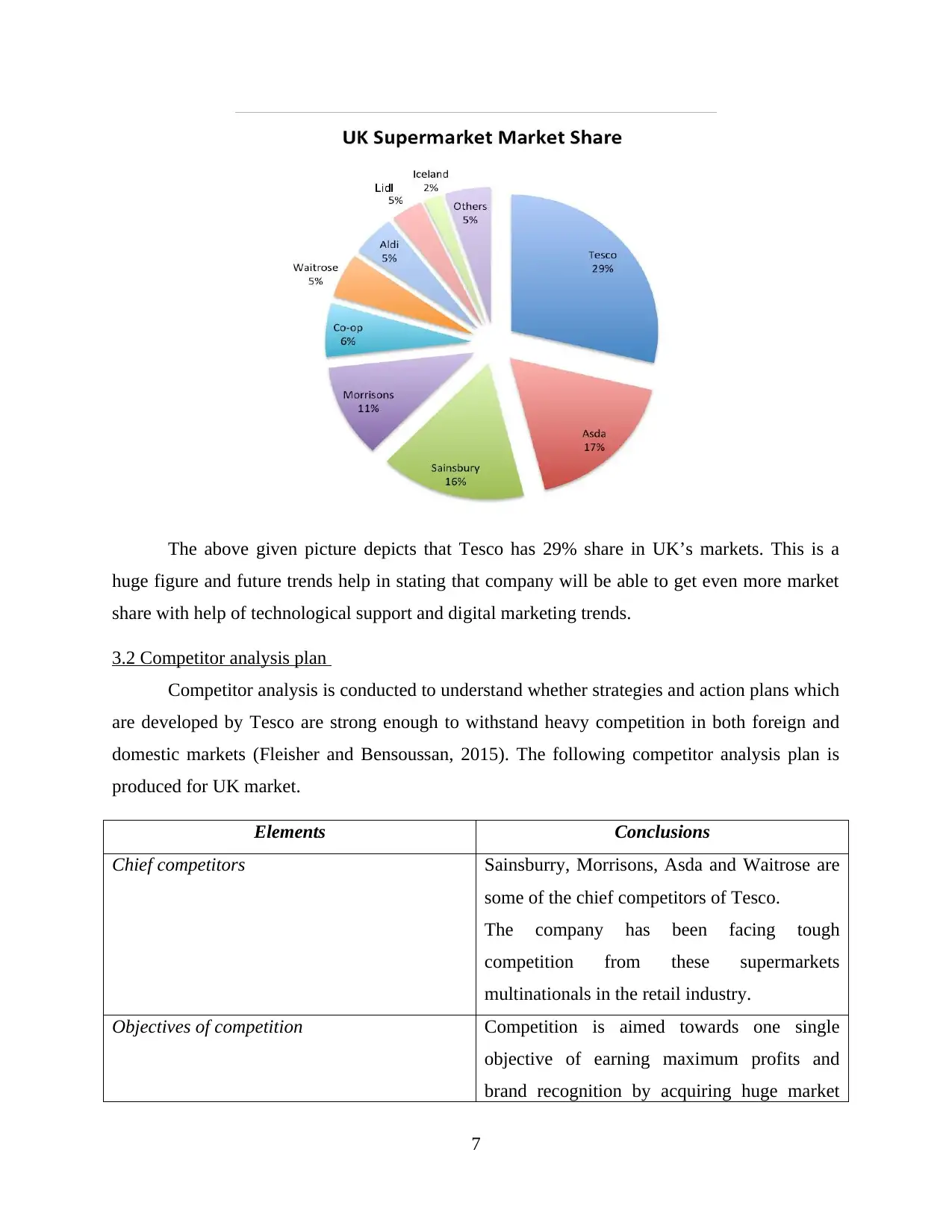
The above given picture depicts that Tesco has 29% share in UK’s markets. This is a
huge figure and future trends help in stating that company will be able to get even more market
share with help of technological support and digital marketing trends.
3.2 Competitor analysis plan
Competitor analysis is conducted to understand whether strategies and action plans which
are developed by Tesco are strong enough to withstand heavy competition in both foreign and
domestic markets (Fleisher and Bensoussan, 2015). The following competitor analysis plan is
produced for UK market.
Elements Conclusions
Chief competitors Sainsburry, Morrisons, Asda and Waitrose are
some of the chief competitors of Tesco.
The company has been facing tough
competition from these supermarkets
multinationals in the retail industry.
Objectives of competition Competition is aimed towards one single
objective of earning maximum profits and
brand recognition by acquiring huge market
7
huge figure and future trends help in stating that company will be able to get even more market
share with help of technological support and digital marketing trends.
3.2 Competitor analysis plan
Competitor analysis is conducted to understand whether strategies and action plans which
are developed by Tesco are strong enough to withstand heavy competition in both foreign and
domestic markets (Fleisher and Bensoussan, 2015). The following competitor analysis plan is
produced for UK market.
Elements Conclusions
Chief competitors Sainsburry, Morrisons, Asda and Waitrose are
some of the chief competitors of Tesco.
The company has been facing tough
competition from these supermarkets
multinationals in the retail industry.
Objectives of competition Competition is aimed towards one single
objective of earning maximum profits and
brand recognition by acquiring huge market
7
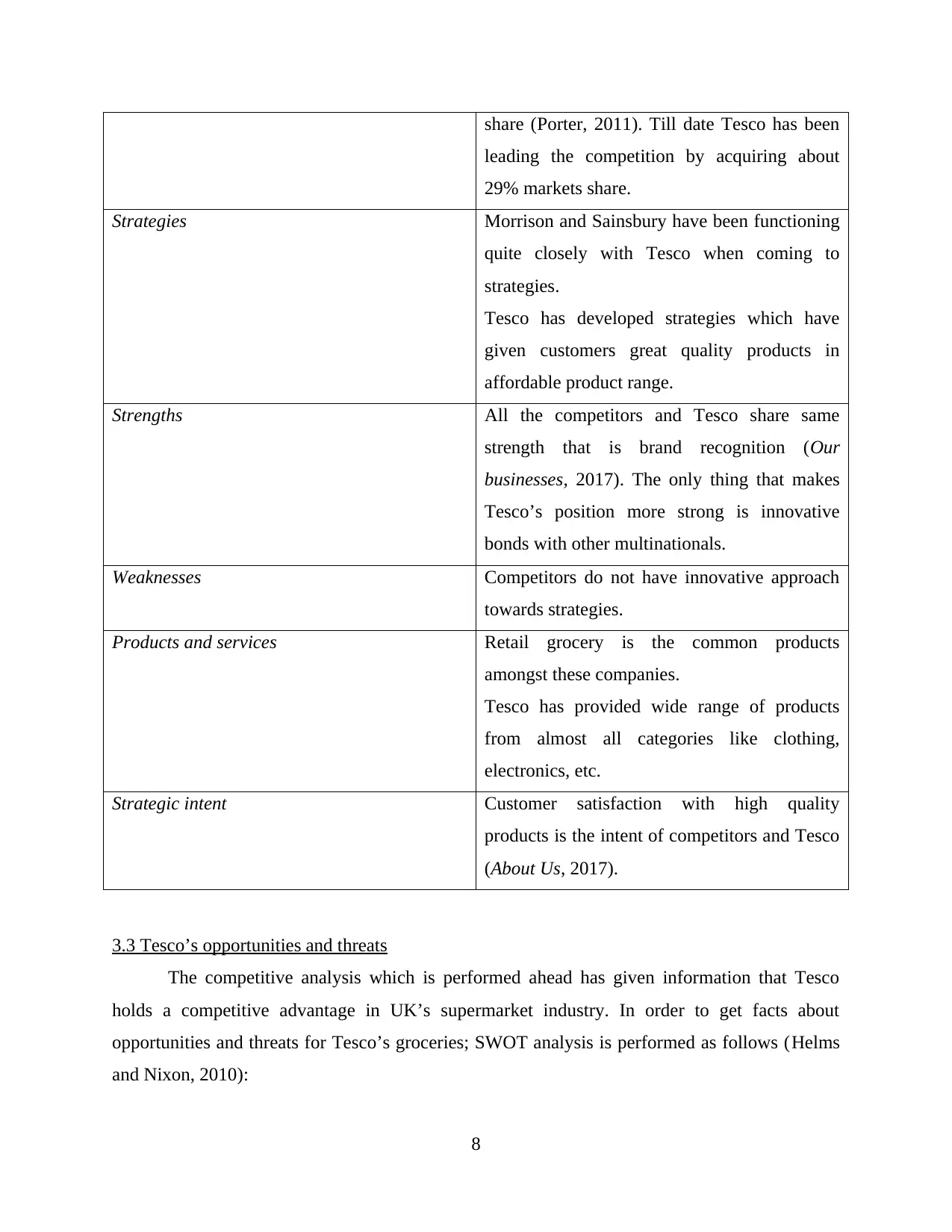
share (Porter, 2011). Till date Tesco has been
leading the competition by acquiring about
29% markets share.
Strategies Morrison and Sainsbury have been functioning
quite closely with Tesco when coming to
strategies.
Tesco has developed strategies which have
given customers great quality products in
affordable product range.
Strengths All the competitors and Tesco share same
strength that is brand recognition (Our
businesses, 2017). The only thing that makes
Tesco’s position more strong is innovative
bonds with other multinationals.
Weaknesses Competitors do not have innovative approach
towards strategies.
Products and services Retail grocery is the common products
amongst these companies.
Tesco has provided wide range of products
from almost all categories like clothing,
electronics, etc.
Strategic intent Customer satisfaction with high quality
products is the intent of competitors and Tesco
(About Us, 2017).
3.3 Tesco’s opportunities and threats
The competitive analysis which is performed ahead has given information that Tesco
holds a competitive advantage in UK’s supermarket industry. In order to get facts about
opportunities and threats for Tesco’s groceries; SWOT analysis is performed as follows (Helms
and Nixon, 2010):
8
leading the competition by acquiring about
29% markets share.
Strategies Morrison and Sainsbury have been functioning
quite closely with Tesco when coming to
strategies.
Tesco has developed strategies which have
given customers great quality products in
affordable product range.
Strengths All the competitors and Tesco share same
strength that is brand recognition (Our
businesses, 2017). The only thing that makes
Tesco’s position more strong is innovative
bonds with other multinationals.
Weaknesses Competitors do not have innovative approach
towards strategies.
Products and services Retail grocery is the common products
amongst these companies.
Tesco has provided wide range of products
from almost all categories like clothing,
electronics, etc.
Strategic intent Customer satisfaction with high quality
products is the intent of competitors and Tesco
(About Us, 2017).
3.3 Tesco’s opportunities and threats
The competitive analysis which is performed ahead has given information that Tesco
holds a competitive advantage in UK’s supermarket industry. In order to get facts about
opportunities and threats for Tesco’s groceries; SWOT analysis is performed as follows (Helms
and Nixon, 2010):
8
Secure Best Marks with AI Grader
Need help grading? Try our AI Grader for instant feedback on your assignments.
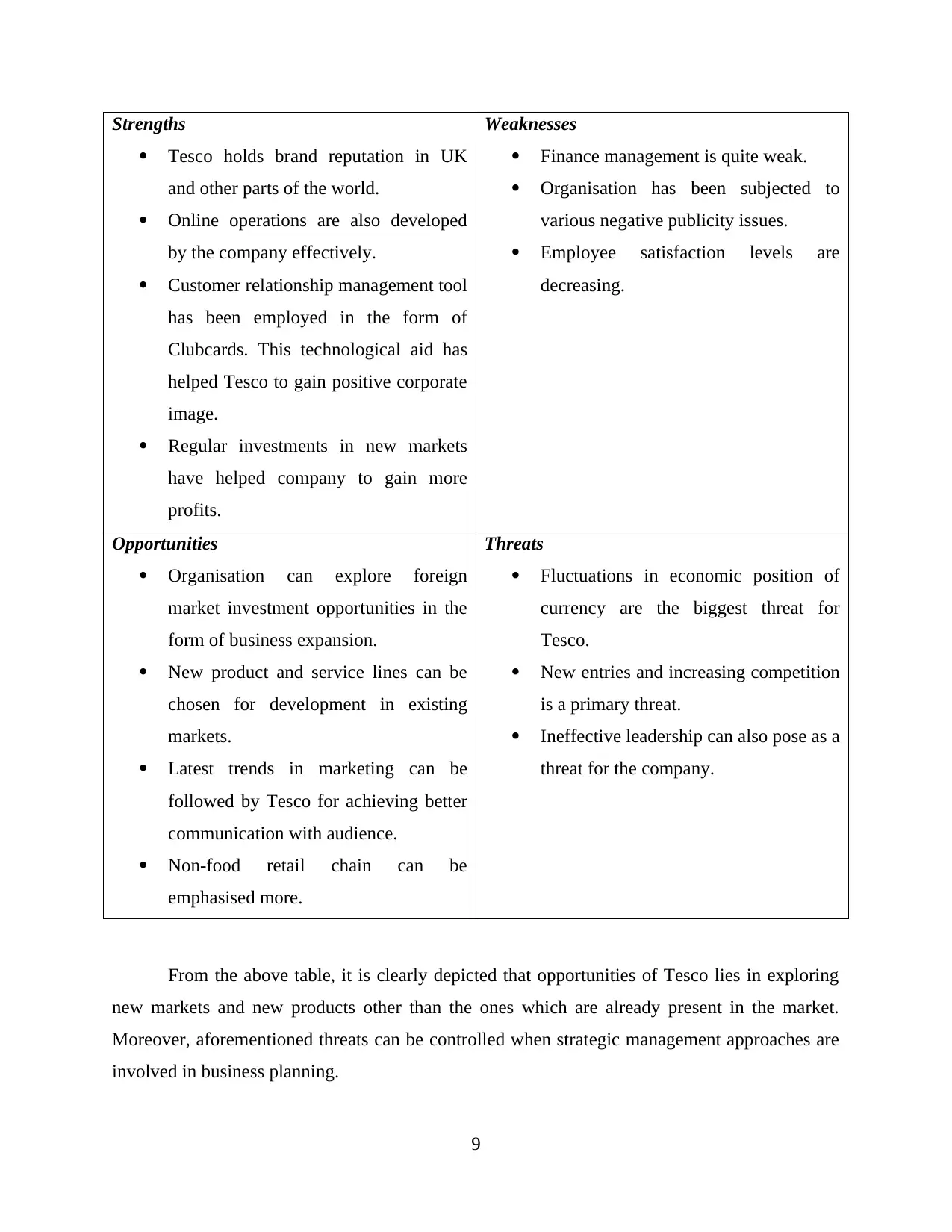
Strengths
Tesco holds brand reputation in UK
and other parts of the world.
Online operations are also developed
by the company effectively.
Customer relationship management tool
has been employed in the form of
Clubcards. This technological aid has
helped Tesco to gain positive corporate
image.
Regular investments in new markets
have helped company to gain more
profits.
Weaknesses
Finance management is quite weak.
Organisation has been subjected to
various negative publicity issues.
Employee satisfaction levels are
decreasing.
Opportunities
Organisation can explore foreign
market investment opportunities in the
form of business expansion.
New product and service lines can be
chosen for development in existing
markets.
Latest trends in marketing can be
followed by Tesco for achieving better
communication with audience.
Non-food retail chain can be
emphasised more.
Threats
Fluctuations in economic position of
currency are the biggest threat for
Tesco.
New entries and increasing competition
is a primary threat.
Ineffective leadership can also pose as a
threat for the company.
From the above table, it is clearly depicted that opportunities of Tesco lies in exploring
new markets and new products other than the ones which are already present in the market.
Moreover, aforementioned threats can be controlled when strategic management approaches are
involved in business planning.
9
Tesco holds brand reputation in UK
and other parts of the world.
Online operations are also developed
by the company effectively.
Customer relationship management tool
has been employed in the form of
Clubcards. This technological aid has
helped Tesco to gain positive corporate
image.
Regular investments in new markets
have helped company to gain more
profits.
Weaknesses
Finance management is quite weak.
Organisation has been subjected to
various negative publicity issues.
Employee satisfaction levels are
decreasing.
Opportunities
Organisation can explore foreign
market investment opportunities in the
form of business expansion.
New product and service lines can be
chosen for development in existing
markets.
Latest trends in marketing can be
followed by Tesco for achieving better
communication with audience.
Non-food retail chain can be
emphasised more.
Threats
Fluctuations in economic position of
currency are the biggest threat for
Tesco.
New entries and increasing competition
is a primary threat.
Ineffective leadership can also pose as a
threat for the company.
From the above table, it is clearly depicted that opportunities of Tesco lies in exploring
new markets and new products other than the ones which are already present in the market.
Moreover, aforementioned threats can be controlled when strategic management approaches are
involved in business planning.
9
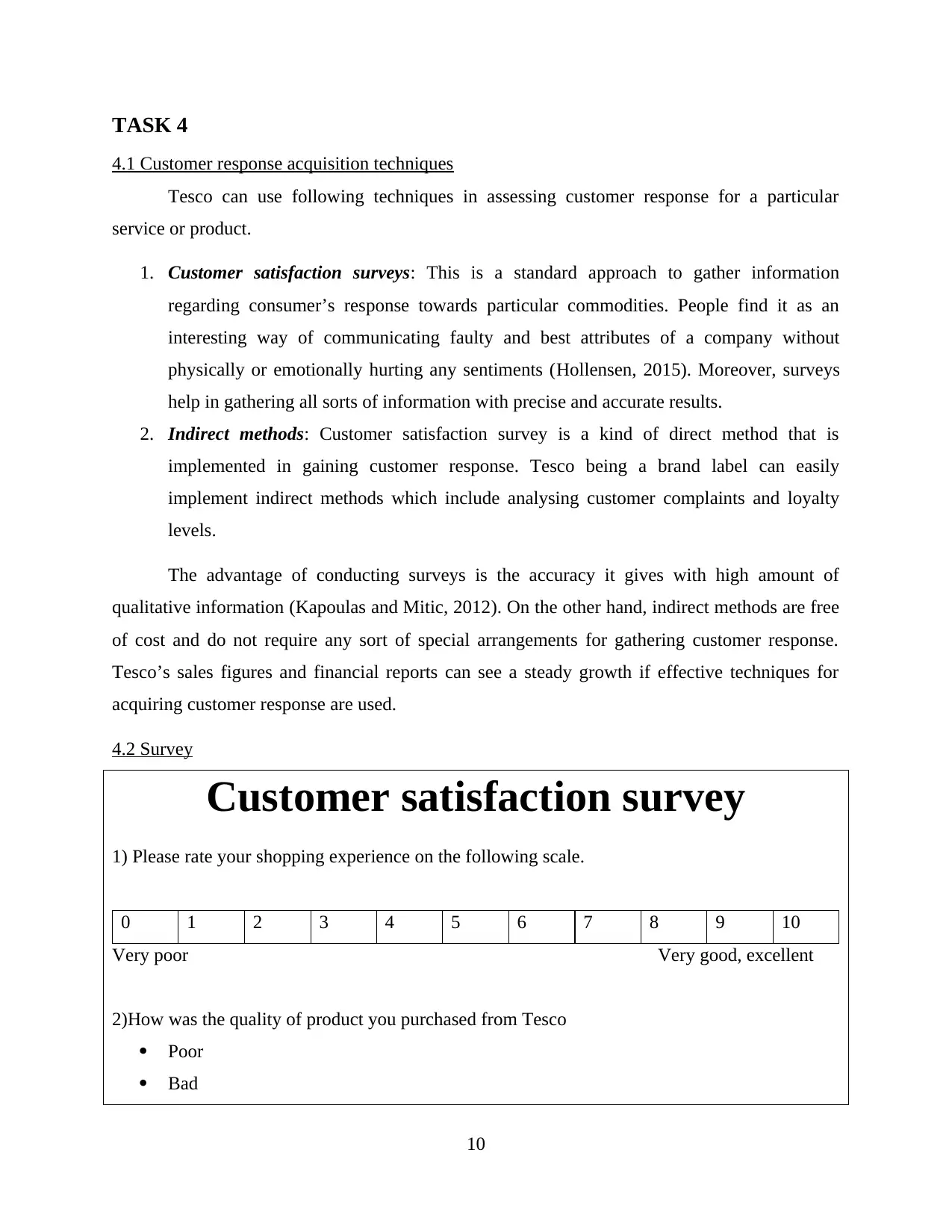
TASK 4
4.1 Customer response acquisition techniques
Tesco can use following techniques in assessing customer response for a particular
service or product.
1. Customer satisfaction surveys: This is a standard approach to gather information
regarding consumer’s response towards particular commodities. People find it as an
interesting way of communicating faulty and best attributes of a company without
physically or emotionally hurting any sentiments (Hollensen, 2015). Moreover, surveys
help in gathering all sorts of information with precise and accurate results.
2. Indirect methods: Customer satisfaction survey is a kind of direct method that is
implemented in gaining customer response. Tesco being a brand label can easily
implement indirect methods which include analysing customer complaints and loyalty
levels.
The advantage of conducting surveys is the accuracy it gives with high amount of
qualitative information (Kapoulas and Mitic, 2012). On the other hand, indirect methods are free
of cost and do not require any sort of special arrangements for gathering customer response.
Tesco’s sales figures and financial reports can see a steady growth if effective techniques for
acquiring customer response are used.
4.2 Survey
Customer satisfaction survey
1) Please rate your shopping experience on the following scale.
0 1 2 3 4 5 6 7 8 9 10
Very poor Very good, excellent
2)How was the quality of product you purchased from Tesco
Poor
Bad
10
4.1 Customer response acquisition techniques
Tesco can use following techniques in assessing customer response for a particular
service or product.
1. Customer satisfaction surveys: This is a standard approach to gather information
regarding consumer’s response towards particular commodities. People find it as an
interesting way of communicating faulty and best attributes of a company without
physically or emotionally hurting any sentiments (Hollensen, 2015). Moreover, surveys
help in gathering all sorts of information with precise and accurate results.
2. Indirect methods: Customer satisfaction survey is a kind of direct method that is
implemented in gaining customer response. Tesco being a brand label can easily
implement indirect methods which include analysing customer complaints and loyalty
levels.
The advantage of conducting surveys is the accuracy it gives with high amount of
qualitative information (Kapoulas and Mitic, 2012). On the other hand, indirect methods are free
of cost and do not require any sort of special arrangements for gathering customer response.
Tesco’s sales figures and financial reports can see a steady growth if effective techniques for
acquiring customer response are used.
4.2 Survey
Customer satisfaction survey
1) Please rate your shopping experience on the following scale.
0 1 2 3 4 5 6 7 8 9 10
Very poor Very good, excellent
2)How was the quality of product you purchased from Tesco
Poor
Bad
10
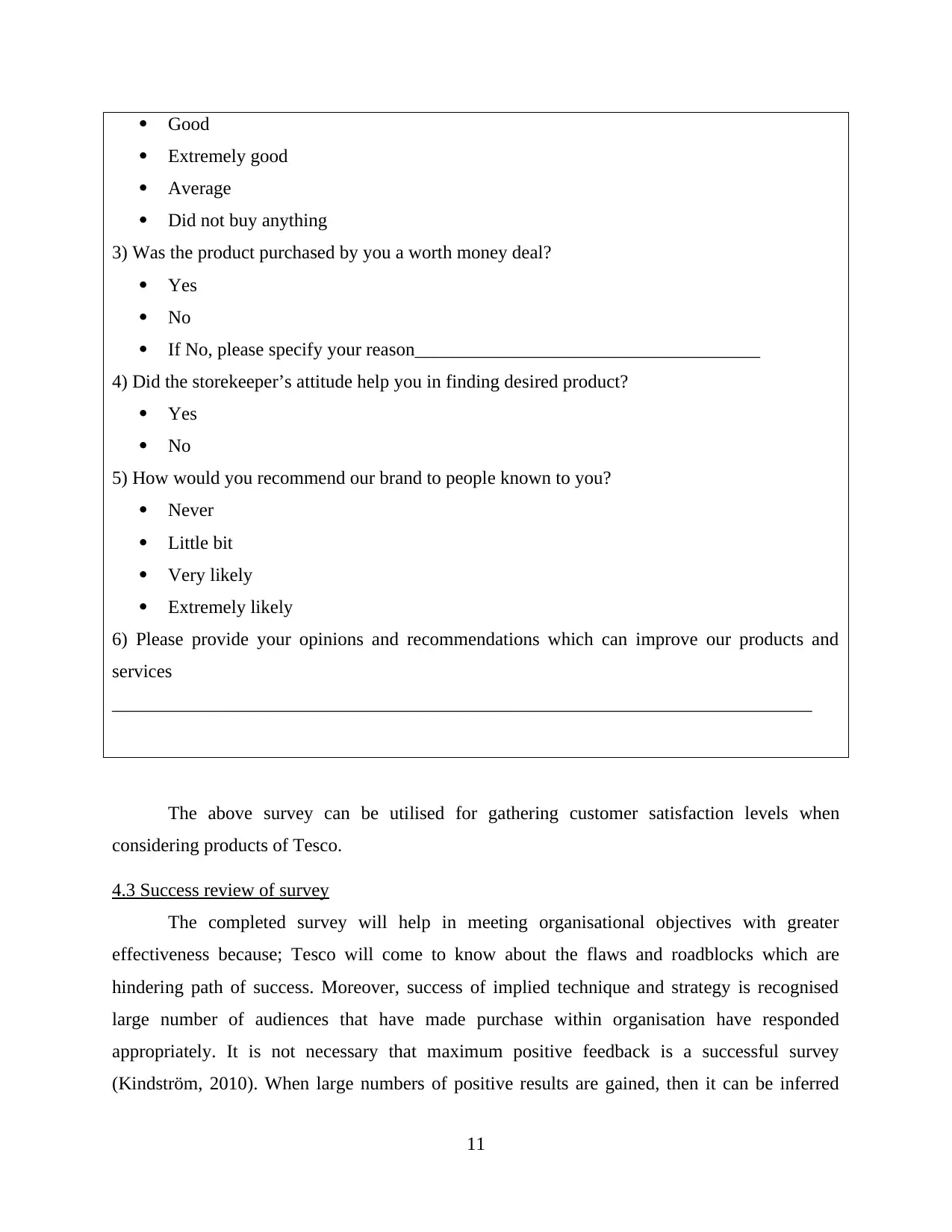
Good
Extremely good
Average
Did not buy anything
3) Was the product purchased by you a worth money deal?
Yes
No
If No, please specify your reason_____________________________________
4) Did the storekeeper’s attitude help you in finding desired product?
Yes
No
5) How would you recommend our brand to people known to you?
Never
Little bit
Very likely
Extremely likely
6) Please provide your opinions and recommendations which can improve our products and
services
___________________________________________________________________________
The above survey can be utilised for gathering customer satisfaction levels when
considering products of Tesco.
4.3 Success review of survey
The completed survey will help in meeting organisational objectives with greater
effectiveness because; Tesco will come to know about the flaws and roadblocks which are
hindering path of success. Moreover, success of implied technique and strategy is recognised
large number of audiences that have made purchase within organisation have responded
appropriately. It is not necessary that maximum positive feedback is a successful survey
(Kindström, 2010). When large numbers of positive results are gained, then it can be inferred
11
Extremely good
Average
Did not buy anything
3) Was the product purchased by you a worth money deal?
Yes
No
If No, please specify your reason_____________________________________
4) Did the storekeeper’s attitude help you in finding desired product?
Yes
No
5) How would you recommend our brand to people known to you?
Never
Little bit
Very likely
Extremely likely
6) Please provide your opinions and recommendations which can improve our products and
services
___________________________________________________________________________
The above survey can be utilised for gathering customer satisfaction levels when
considering products of Tesco.
4.3 Success review of survey
The completed survey will help in meeting organisational objectives with greater
effectiveness because; Tesco will come to know about the flaws and roadblocks which are
hindering path of success. Moreover, success of implied technique and strategy is recognised
large number of audiences that have made purchase within organisation have responded
appropriately. It is not necessary that maximum positive feedback is a successful survey
(Kindström, 2010). When large numbers of positive results are gained, then it can be inferred
11
Paraphrase This Document
Need a fresh take? Get an instant paraphrase of this document with our AI Paraphraser

that company’s strategies and products are effective and efficient enough to fulfil customer
demands. On the other hand, a large quantity of response indicates a successful survey. These
kinds of customer responses help in implementing strategies with certain specific improvements
and preventive measure which will contribute to achieving business objectives.
CONCLUSION
This report is an informative assessment which provides details about Tesco’s
functioning structure when a consumer make certain purchase decisions. From description of
buyer decision making process to relation between brand loyalty and repeat purchasing, this
report provides facts that will help in understanding buyer behaviour. Moreover, a market
research plan is produced for Tesco which help the company to achieve set objectives by
gathering information from various sources and techniques as stated. Additionally, current
market size trends are also discussed with help of competitive analysis that is performed above.
The conducted competitive analysis helps in gaining an understanding about reasons behind
Tesco’s success. Lastly, a questionnaire has been provided for getting data regarding customer
satisfaction for Tesco.
12
demands. On the other hand, a large quantity of response indicates a successful survey. These
kinds of customer responses help in implementing strategies with certain specific improvements
and preventive measure which will contribute to achieving business objectives.
CONCLUSION
This report is an informative assessment which provides details about Tesco’s
functioning structure when a consumer make certain purchase decisions. From description of
buyer decision making process to relation between brand loyalty and repeat purchasing, this
report provides facts that will help in understanding buyer behaviour. Moreover, a market
research plan is produced for Tesco which help the company to achieve set objectives by
gathering information from various sources and techniques as stated. Additionally, current
market size trends are also discussed with help of competitive analysis that is performed above.
The conducted competitive analysis helps in gaining an understanding about reasons behind
Tesco’s success. Lastly, a questionnaire has been provided for getting data regarding customer
satisfaction for Tesco.
12

REFERENCES
Books and Journals
Armstrong, G. and et. al., 2012. Marketing: an introduction. Pearson Prentice-Hall, London.
Clark, R. M., 2016. Intelligence analysis: a target-centric approach. CQ press.
Fleisher, C.S. and Bensoussan, B.E., 2015. Business and competitive analysis: effective
application of new and classic methods. FT Press.
Goffin, K., Varnes, C. J., van der Hoven, C. and Koners, U., 2012. Beyond the voice of the
customer: Ethnographic market research. Research-Technology Management, 55(4), pp.45-
53.
Helms, M. M. and Nixon, J., 2010. Exploring SWOT analysis–where are we now? A review of
academic research from the last decade. Journal of strategy and management, 3(3),
pp.215-251.
Hollensen, S., 2015. Marketing management: A relationship approach. Pearson Education.
Kapoulas, A. and Mitic, M., 2012. Understanding challenges of qualitative research: rhetorical
issues and reality traps. Qualitative Market Research: An International Journal, 15(4),
pp.354-368.
Kindström, D., 2010. Towards a service-based business model–Key aspects for future
competitive advantage. European Management Journal, 28(6), pp.479-490.
Lee, M. S., Hsiao, H. D. and Yang, M. F., 2010. The study of the relationships among
experiential marketing, service quality, customer satisfaction and customer
loyalty. International Journal of Organizational Innovation (Online), 3(2), p.352.
Patino, A., Pitta, D. A. and Quinones, R., 2012. Social media's emerging importance in market
research. Journal of Consumer Marketing, 29(3), pp.233-237.
Porter, M. E., 2011. Competitive advantage of nations: creating and sustaining superior
performance. Simon and Schuster.
Racz, N., Weippl, E. and Seufert, A., 2011, January. Governance, risk & compliance (GRC)
software-an exploratory study of software vendor and market research perspectives.
In System Sciences (HICSS), 2011 44th Hawaii International Conference on (pp. 1-10).
IEEE.
Ramsay, J., Wagner, B. and Kelly, S., 2013. Purchase offering quality: The effects of buyer
behaviour on organizational supplying behaviour. International Journal of Operations &
Production Management, 33(10), pp.1260-1282.
Ryu, K. and Han, H., 2010. Influence of the quality of food, service, and physical environment
on customer satisfaction and behavioral intention in quick-casual restaurants: Moderating
role of perceived price. Journal of Hospitality & Tourism Research, 34(3), pp.310-329.
1
Books and Journals
Armstrong, G. and et. al., 2012. Marketing: an introduction. Pearson Prentice-Hall, London.
Clark, R. M., 2016. Intelligence analysis: a target-centric approach. CQ press.
Fleisher, C.S. and Bensoussan, B.E., 2015. Business and competitive analysis: effective
application of new and classic methods. FT Press.
Goffin, K., Varnes, C. J., van der Hoven, C. and Koners, U., 2012. Beyond the voice of the
customer: Ethnographic market research. Research-Technology Management, 55(4), pp.45-
53.
Helms, M. M. and Nixon, J., 2010. Exploring SWOT analysis–where are we now? A review of
academic research from the last decade. Journal of strategy and management, 3(3),
pp.215-251.
Hollensen, S., 2015. Marketing management: A relationship approach. Pearson Education.
Kapoulas, A. and Mitic, M., 2012. Understanding challenges of qualitative research: rhetorical
issues and reality traps. Qualitative Market Research: An International Journal, 15(4),
pp.354-368.
Kindström, D., 2010. Towards a service-based business model–Key aspects for future
competitive advantage. European Management Journal, 28(6), pp.479-490.
Lee, M. S., Hsiao, H. D. and Yang, M. F., 2010. The study of the relationships among
experiential marketing, service quality, customer satisfaction and customer
loyalty. International Journal of Organizational Innovation (Online), 3(2), p.352.
Patino, A., Pitta, D. A. and Quinones, R., 2012. Social media's emerging importance in market
research. Journal of Consumer Marketing, 29(3), pp.233-237.
Porter, M. E., 2011. Competitive advantage of nations: creating and sustaining superior
performance. Simon and Schuster.
Racz, N., Weippl, E. and Seufert, A., 2011, January. Governance, risk & compliance (GRC)
software-an exploratory study of software vendor and market research perspectives.
In System Sciences (HICSS), 2011 44th Hawaii International Conference on (pp. 1-10).
IEEE.
Ramsay, J., Wagner, B. and Kelly, S., 2013. Purchase offering quality: The effects of buyer
behaviour on organizational supplying behaviour. International Journal of Operations &
Production Management, 33(10), pp.1260-1282.
Ryu, K. and Han, H., 2010. Influence of the quality of food, service, and physical environment
on customer satisfaction and behavioral intention in quick-casual restaurants: Moderating
role of perceived price. Journal of Hospitality & Tourism Research, 34(3), pp.310-329.
1
1 out of 15
Related Documents
Your All-in-One AI-Powered Toolkit for Academic Success.
+13062052269
info@desklib.com
Available 24*7 on WhatsApp / Email
![[object Object]](/_next/static/media/star-bottom.7253800d.svg)
Unlock your academic potential
© 2024 | Zucol Services PVT LTD | All rights reserved.





